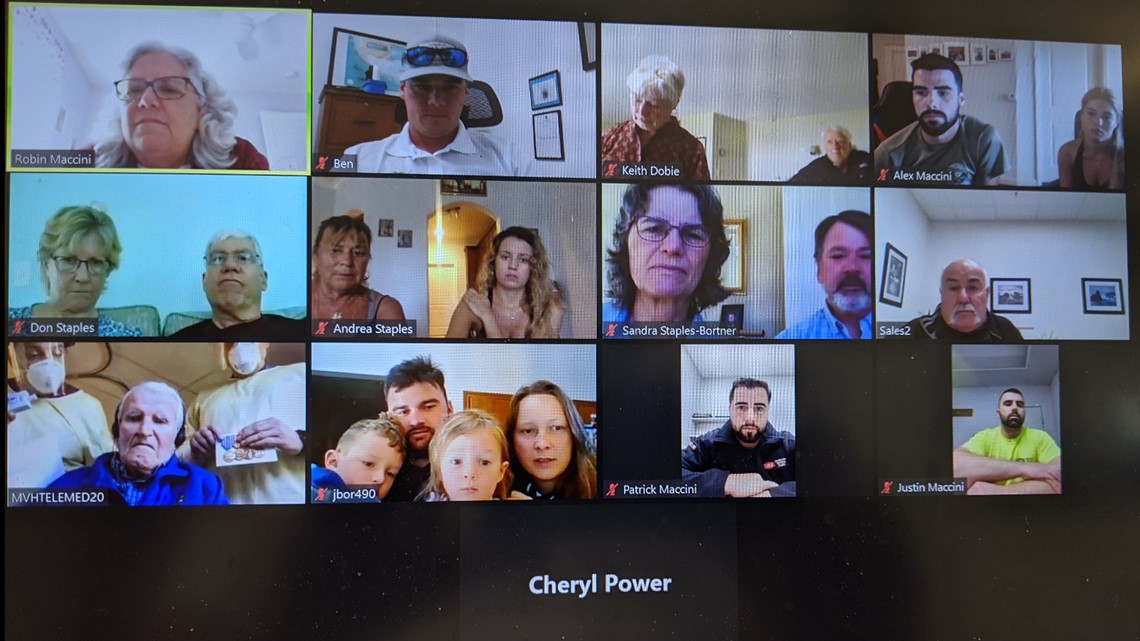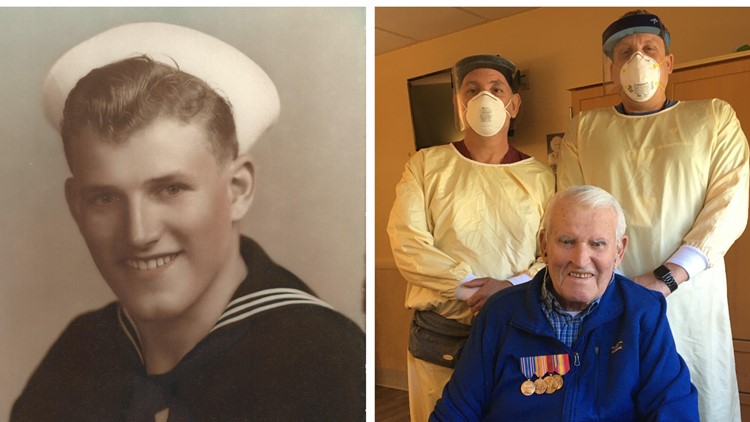SCARBOROUGH, Maine — Longtime Falmouth resident Don Staples Sr. has had some tough times in his life, including his service in the U.S. Navy. But surviving COVID-19 was a lot to endure for the 92-year old. To cheer him up, his family recently arranged for the Veteran of both World War II and the Korean War to receive his long overdue military service medals.
The following information was provided by Staples' daughter, Sandra Staples-Bortner.
Survives COVID-19
Staples was more fortunate than some others at Maine Veterans Homes - Scarborough and, while he tested positive for coronavirus, he had none of the life threatening lung or heart symptoms. He did endure two months of isolation in his room surrounded by caretakers who wore full protective gear, including gowns, face masks and face shields. Since mid March, he saw family members only during occasional Skype calls and later window visits were added. For someone with moderate dementia, this turned his world upside down. He lost 38 pounds and couldn’t understand what had happened to change his world so dramatically.
By mid May, things were beginning to turn around for him. On May 15 he resumed physical therapy which included an extended walk around his wing and enjoyed his first ‘social distancing’ happy hour in months on the outside patio. The next morning, he overestimated his strength and fell and broke his hip. That led to a brief stay in the hospital, without family allowed to be by his side, and a partial hip replacement.
Overdue Medals
Now back at Maine Veterans Homes - Scarborough, his family wanted to brighten his day. They recalled his pride in his Navy service, serving in World War II as a 17-year-old and later in the Korean War. Family researched his military record, ordered the appropriate medals, and arranged for staff of the Home to present them in a brief pinning ceremony that was observed by family—children, grandchildren, great grandchildren, and others—via Zoom. While a few tears were shed by proud family members, Staples sat at attention in his wheelchair, quietly reflected on the moment and later said, “It was an honor just to be allowed to serve.


Serves in World War II and Korean War
Staples served on the USS Chandeleur during World War II. The Seaman First Class was told by his father not to volunteer for any duty. But Don, who had been lobstering from a small skiff since he was 11 years old, couldn’t help it—he raised his hand when asked if anyone knew how to run a boat. It was 1945 and he had spent 40 days traveling the Pacific on a troop carrier before being dropped off on his new ship on March 28 at Kerama Retto, a Japanese archipelago that served as a supply and maintenance anchorage for U.S. ships involved in the Battle of Okinawa. On April 1, three days after Don’s arrival, the initial U.S. assault began on Okinawa.
The Chandeleur was a seaplane tender. Seaplanes from the ship flew reconnaissance runs looking for enemy ships and submarines, and then called in bombers. The Chandeleur’s seaplanes took part in sinking the Japanese submarine I-8 off Okinawa on March 31, and on April 7 spotted the Japanese battleship Yamato, which was then sunk by aircraft carrier bombers.
Seaman First Class Staples was responsible for running a 35-foot re-arming boat. He had one crewman, who was a Second Class Aviation Mechanic. “He outranked me by a lot and wasn’t very happy about working for a lowly seaman. But I was running the boat, so I was in charge,” Don said. His job was to take flight and repair crews to and from the seaplanes moored nearby. He also ferried officers and men to different ships throughout the day.
RELATED: Behind each statistic is a story: Dr. Nirav Shah shares story of Maine woman who died in her 100s
“One day I was given the job of taking Captain Tracy over to the Battleship Maryland. There were 14-foot swells—they came up so high, it scared you,” Staples recalled. “When we got to the Battleship Maryland, my boat was rising up and down with the swells and I knew it would be tricky to get the captain off safely. My boat was just a small toy next to the battleship.”
The Seaman First Class timed the swells and told his captain exactly when to step off. He repeated this again when it was time for the captain to board the small boat once again. “He never got his feet wet; he never got washed overboard either,” Don said.
His skill apparently caught the eye of the captain as, later that day, Staples was in his quarters when he was ordered to the fantail. A man there asked him five questions, after which he was told that he was now a Third Class Aviation Boatswain Mate, retroactive 30 days. “I was shocked. It takes a long time to make Third Class. At 17, I was the youngest Third Class aboard ship,” he recalled.
One day Staples was called to the quarter deck and instructed to pick up an 11-member crew from a seaplane known as a PBM that had just landed. While he was on his way, he saw that the crew of another seaplane, a PB4Y from another ship, was in trouble. The PB4Y wouldn’t turn and was on a path to drive its fast-moving outside propeller into the moored PBM and its crew.
“It would have been a disaster,” he said.
Staples made a slashing sign across his throat to the pilot of the distressed PB4Y to tell him to cut the engine and told his own crewman to hit the deck. Don steered his boat under the wing of the moored PBM, right at the bow of the moving PB4Y.
“We hit him hard, putting a dent in the seaplane, because I had to push him back quick. It was a helluva decision I made, but I had to do it,” Staples said. The pilot of the PB4Y was so impressed with his heroic action that he wrote up a commendation and gave it to Don. “Apparently, Captain Tracy never got a copy as I never got a medal,” he said.
After Staples’ service in World War II, he stayed on with the Navy Reserves and was called up during the Korean War, serving from 1951 to 1952 aboard the USS Salerno Bay, a small aircraft carrier. A Third Class Aviation Boatswain Mate, he was in charge of the flight deck crew which consisted of 66 new recruits just out of boot camp. “We passed our test the first time, receiving a rating of E for Excellent, and getting in good with the captain,” Staples said of their first sea trial. “I always took pride in doing a good job.”
After completing sea trials at Guantanamo Bay, Cuba, the ship was at sea in the Atlantic Ocean. “One time we had a Russian submarine down for 21 days,” said Staples. “When my time aboard the ship came to an end, the captain and officers lined up to salute me as I departed the ship for the last time,” recalled Don. “That was quite an honor.”
While the Staples family found no record of the commendation made by the grateful PB4Y seaplane pilot from World War II in Don’s military records, they were able to get him the medals he earned for his service:
• World War II American Campaign Medal
• World War II Asiatic Pacific Medal
• World War II Victory Medal
• National Defense Service Medal – Korean War
At the end of World War II, metal was a scarce commodity and service medals were not routinely presented. Busy with his life, Don never sought them out in later years. But as the years went on, he reflected more on his service and proudly shared his war stories. Surely, family reasoned, a pinning ceremony to receive long overdue service medals would put the gleam in his eye once again. They were right.



